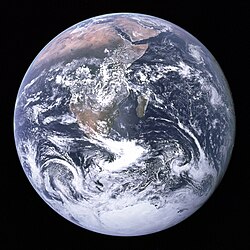Earth
From English Penguinapedia
| Line 3: | Line 3: | ||
It is also the largest of the Solar System's four [[terrestrial planet]]s. It is sometimes referred to as the [[World]], the Blue Planet | It is also the largest of the Solar System's four [[terrestrial planet]]s. It is sometimes referred to as the [[World]], the Blue Planet | ||
Earth's [[Crust (geology)|outer surface]] is divided into several rigid segments, or [[tectonic plate]]s, that migrate across the surface over periods of [[Geologic time scale|many millions of years]]. About 71% of the surface is covered by salt water oceans, with the remainder consisting of continents and islands which together have many lakes and other sources of water that contribute to the [[hydrosphere]]. Earth's [[Geographical pole|poles]] are mostly covered with solid ice ([[Antarctic ice sheet]]) or [[sea ice]] ([[Arctic ice cap]]). [[Structure of the Earth|The planet's interior]] remains active, with a thick layer of relatively solid [[Mantle (geology)|mantle]], a liquid [[outer core]] that generates a magnetic field, and a solid iron [[inner core]]. | Earth's [[Crust (geology)|outer surface]] is divided into several rigid segments, or [[tectonic plate]]s, that migrate across the surface over periods of [[Geologic time scale|many millions of years]]. About 71% of the surface is covered by salt water oceans, with the remainder consisting of continents and islands which together have many lakes and other sources of water that contribute to the [[hydrosphere]]. Earth's [[Geographical pole|poles]] are mostly covered with solid ice ([[Antarctic ice sheet]]) or [[sea ice]] ([[Arctic ice cap]]). [[Structure of the Earth|The planet's interior]] remains active, with a thick layer of relatively solid [[Mantle (geology)|mantle]], a liquid [[outer core]] that generates a magnetic field, and a solid iron [[inner core]]. | ||
| + | |||
| + | |||
| + | |||
| + | |||
| + | |||
| + | |||
| + | |||
| + | |||
http://upload.wikimedia.org/wikipedia/commons/thumb/9/97/The_Earth_seen_from_Apollo_17.jpg/250px-The_Earth_seen_from_Apollo_17.jpg | http://upload.wikimedia.org/wikipedia/commons/thumb/9/97/The_Earth_seen_from_Apollo_17.jpg/250px-The_Earth_seen_from_Apollo_17.jpg | ||
Current revision as of 00:50, 19 November 2011
Earth (or the Earth) is the third planet from the Sun, and the densest and fifth-largest of the eight planets in the Solar System.
It is also the largest of the Solar System's four terrestrial planets. It is sometimes referred to as the World, the Blue Planet Earth's outer surface is divided into several rigid segments, or tectonic plates, that migrate across the surface over periods of many millions of years. About 71% of the surface is covered by salt water oceans, with the remainder consisting of continents and islands which together have many lakes and other sources of water that contribute to the hydrosphere. Earth's poles are mostly covered with solid ice (Antarctic ice sheet) or sea ice (Arctic ice cap). The planet's interior remains active, with a thick layer of relatively solid mantle, a liquid outer core that generates a magnetic field, and a solid iron inner core.

